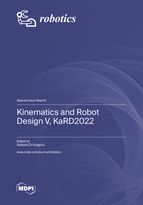Kinematics and Robot Design V, KaRD2022
A special issue of Robotics (ISSN 2218-6581).
Deadline for manuscript submissions: closed (15 December 2022) | Viewed by 50524
Special Issue Editor
Interests: kinematics; dynamics; mechanism and machine theory; parallel manipulators; robot mechanics; biomechanics; vehicle mechanics; robotics
Special Issues, Collections and Topics in MDPI journals
Special Issue Information
Scientific Committee
- Massimo Callegari, Polytechnic University of Marche (Italy)
- Juan Antonio Carretero, University of New Brunswick (Canada)
- Yan Chen, Tianjin University (China)
- Daniel Condurache, “Gheorghe Asachi” Technical University of Iași (Romania)
- Xilun Ding, Beijing University of Aeronautics & Astronautics (China)
- Mary Frecker, Penn State - College of Engineering (USA)
- Clement Gosselin, Laval University (Canada)
- Just Herder, TU Deft (Netherlands)
- Larry Howell, Brigham Young University (USA)
- Xianwen Kong, Heriot-Watt University (UK)
- Pierre Larochelle, South Dakota School of Mines & Technology (USA)
- Giovanni Legnani, University of Brescia (Italy)
- Haitao Liu, Tianjin University (China)
- Daniel Martins, Universidade Federal de Santa Catarina (Brazil)
- Andreas Mueller, Johannes Kepler Universität (Austria)
- Andrew Murray, University of Dayton (USA)
- Leila Notash, Queen's University (Canada)
- Matteo Palpacelli, Polytechnic University of Marche (Italy)
- Alba Perez, Remy Robotics, Barcelona (Spain)
- Victor Petuya, University of the Basque Country (Spain)
- José Maria Rico Martinez, Universidad de Guanajuato (Mexico)
- Nina Robson, California State University, Fullerton (USA)
- Jon M. Selig, London South Bank University (UK)
- Bruno Siciliano, University of Naples Federico II (Italy)
- Tao Sun, Tianjin University (China)
- Yukio Takeda, Tokyo Institute of Technology (Japan)
- Federico Thomas, Institute of Industrial Robotics (Spain)
- Volkert Van Der Wijk, TU Deft (Netherlands)
Dear Colleagues,
KaRD2022 is the 5th issue of the KaRD series, hosted by MDPI’s Robotics. The KaRD series of open access Special Issues is characterized with low publication costs (CHF 400 /paper is the author processing fee (APC) for each published paper), which is comparable to the registration fee of a small international congress.
The KaRD series started in 2018 and publishes one issue annually. Its websites are an open environment where researchers can present their works and discuss all the topics focused on the many aspects that involve kinematics in the design of robotic/automatic systems by using supplementary multimedia materials uploadable during submission. A “Scientific Committee”, which collects researchers from all over the world, supports and supervises the Guest Editor activity.
All the papers are peer-reviewed as soon as they are submitted and, if accepted, are immediately published on MDPI’s Robotics and appear on the website of the KaRD issue. Starting with the last edition, the papers of each KaRD issue are also collected into freely downloadable e-books, the printed copy of which can also be ordered at a price that covers the printing costs.
Kinematics is central for nearly all the design aspects of robotic/automatic systems. Topics such as analysis and synthesis of mechanisms, robot modeling and simulation, robot control, mobility and singularity analysis, performance measures, accuracy analysis, path planning, and obstacle avoidance, collaborative robotics, novel manipulator architectures, metamorphic mechanisms, compliant mechanism analysis and synthesis, micro/nano-manipulator design, origami-based robotics, medical and rehabilitation robotics, bioinspired robotics, etc., deal with kinematics. All these topics have a deep social impact and, somehow, delineate future perspectives of human welfare, which makes kinematics an alive research field for theoretical and applicative subjects.
KaRD2022 provides a good opportunity for presenting research results that are immediately readable and usable by other researchers. In particular, submitting authors:
- Are able to also submit accompanying multimedia material;
- Can request the “Open Peer Review” during the submission;
- Are immediately able to upload, as a preprint on https://www.preprints.org/, the paper version submitted for review, where it will receive a DOI and will be readable/citable by other researchers;
- After the possible paper acceptance and the publication on Robotics, are able to upload their published paper on many social networks for researchers (e.g., ResearchGate.net), where they can publicly or privately interact with other researchers to start a discussion on the published results.
In short, KaRD series is an “agora”, where researchers efficiently exchange their experiences.
The Special Issue aims at collecting recent research on the following topics. Nevertheless, review papers are welcome, too.
Topics of interest include (but are not limited to):
- Synthesis of mechanisms;
- Theoretical and computational kinematics;
- Robot modeling and simulation;
- Kinematics in robot control;
- Position analysis;
- Mobility and singularity analysis;
- Performance measures;
- Accuracy analysis;
- Path planning and obstacle avoidance;
- Novel manipulator architectures;
- Metamorphic mechanisms;
- Compliant mechanism analysis and synthesis;
- Micro/nano manipulator design;
- Origami-based robotics;
- Medical and rehabilitation robotics;
- Kinematics in biological systems, humanoid robots, and humanoid subsystems;
- Education in robotics.
Raffaele Di Gregorio
Guest Editor
Manuscript Submission Information
Manuscripts should be submitted online at www.mdpi.com by registering and logging in to this website. Once you are registered, click here to go to the submission form. Manuscripts can be submitted until the deadline. All submissions that pass pre-check are peer-reviewed. Accepted papers will be published continuously in the journal (as soon as accepted) and will be listed together on the special issue website. Research articles, review articles as well as short communications are invited. For planned papers, a title and short abstract (about 100 words) can be sent to the Editorial Office for announcement on this website.
Submitted manuscripts should not have been published previously, nor be under consideration for publication elsewhere (except conference proceedings papers). All manuscripts are thoroughly refereed through a single-blind peer-review process. A guide for authors and other relevant information for submission of manuscripts is available on the Instructions for Authors page. Robotics is an international peer-reviewed open access semimonthly journal published by MDPI.
Please visit the Instructions for Authors page before submitting a manuscript. The Article Processing Charge (APC) for publication in this open access journal is 1600 CHF (Swiss Francs), but it is reduced to 400 CHF for the papers submitted to this special issue. Submitted papers should be well formatted and use good English. Authors may use MDPI's English editing service prior to publication or during author revisions.
Keywords
- mechanism synthesis
- kinematic analysis
- robot modeling and simulation
- robot control
- singularity analysis
- performance measures
- accuracy analysis
- path planning
- parallel manipulator
- serial manipulator
- robot design
- compliant mechanism
- micro/nano manipulator
- origami
- medical and rehabilitation robotics
- biomechanics
Related Special Issues
- Kinematics and Robot Design VI, KaRD2023 in Robotics (10 articles)
- Kinematics and Robot Design I, KaRD2018 in Robotics (14 articles)
- Kinematics and Robot Design II, KaRD2019 in Robotics (7 articles)
- Kinematics and Robot Design III, KaRD2020 in Robotics (10 articles)
- Kinematics and Robot Design IV, KaRD2021 in Robotics (12 articles)






